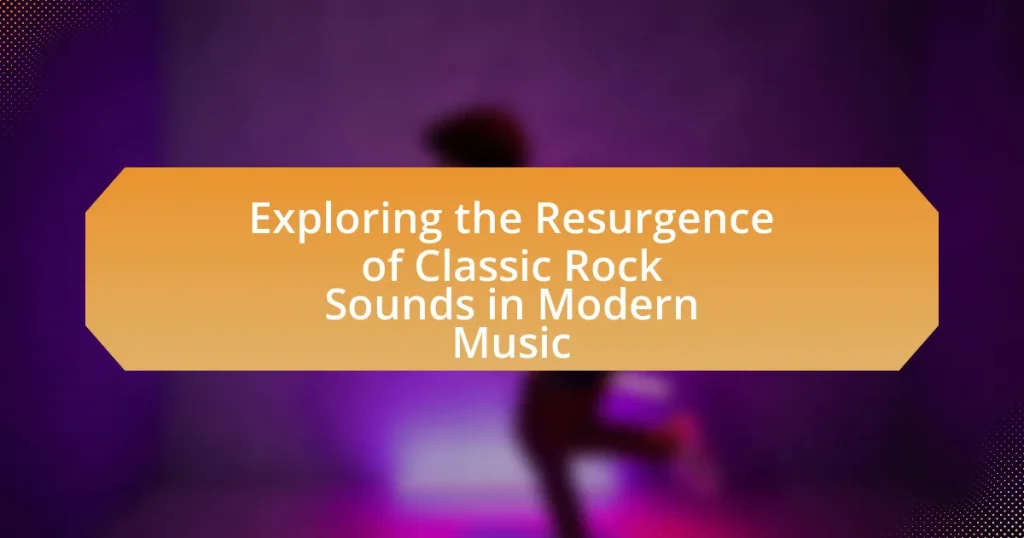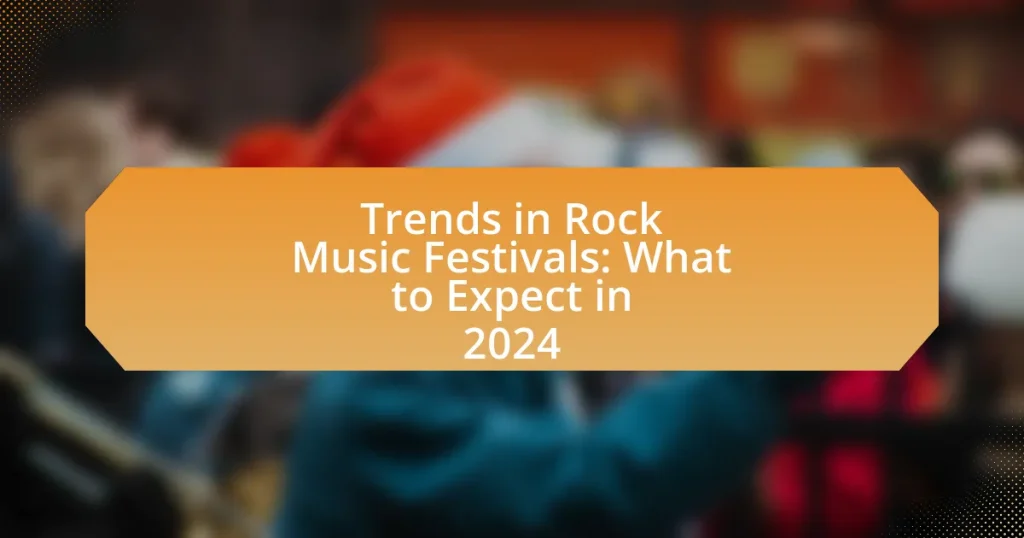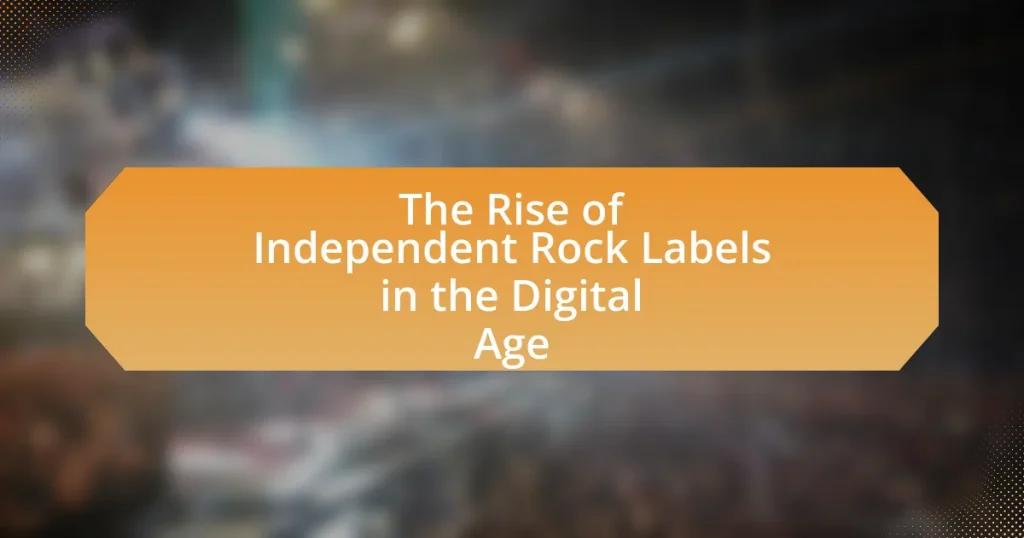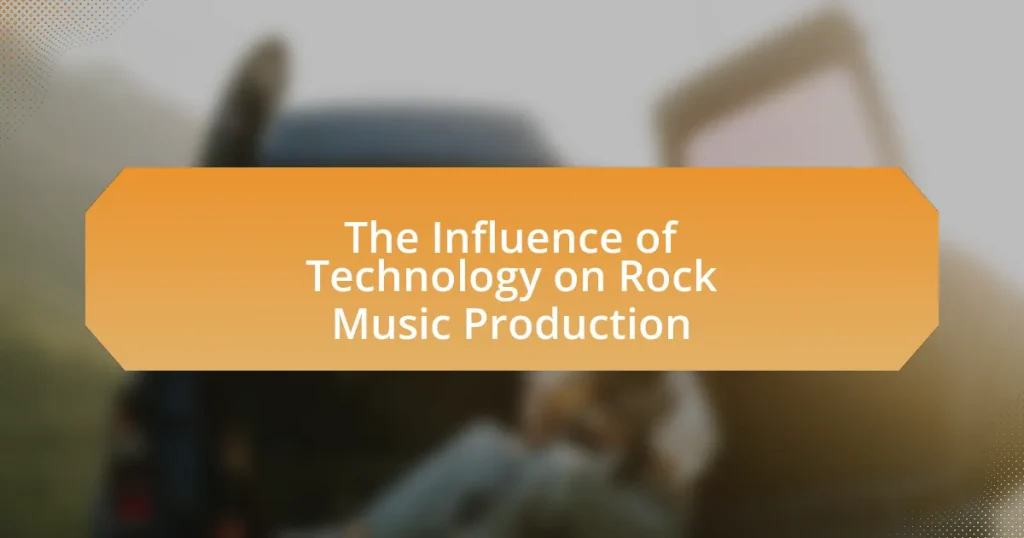The article explores the resurgence of classic rock sounds in modern music, highlighting the renewed popularity of musical elements such as guitar riffs, anthemic choruses, and vintage production techniques. It examines how contemporary artists like Greta Van Fleet and The Struts draw inspiration from legendary bands, leading to increased streaming numbers and chart success for classic rock-inspired albums. The piece also discusses the influence of classic rock on various genres, the role of nostalgia and generational shifts in this trend, and the impact of music festivals and live performances on audience perceptions. Additionally, it addresses the challenges modern artists face in balancing originality with homage to classic rock while navigating criticisms from purists.
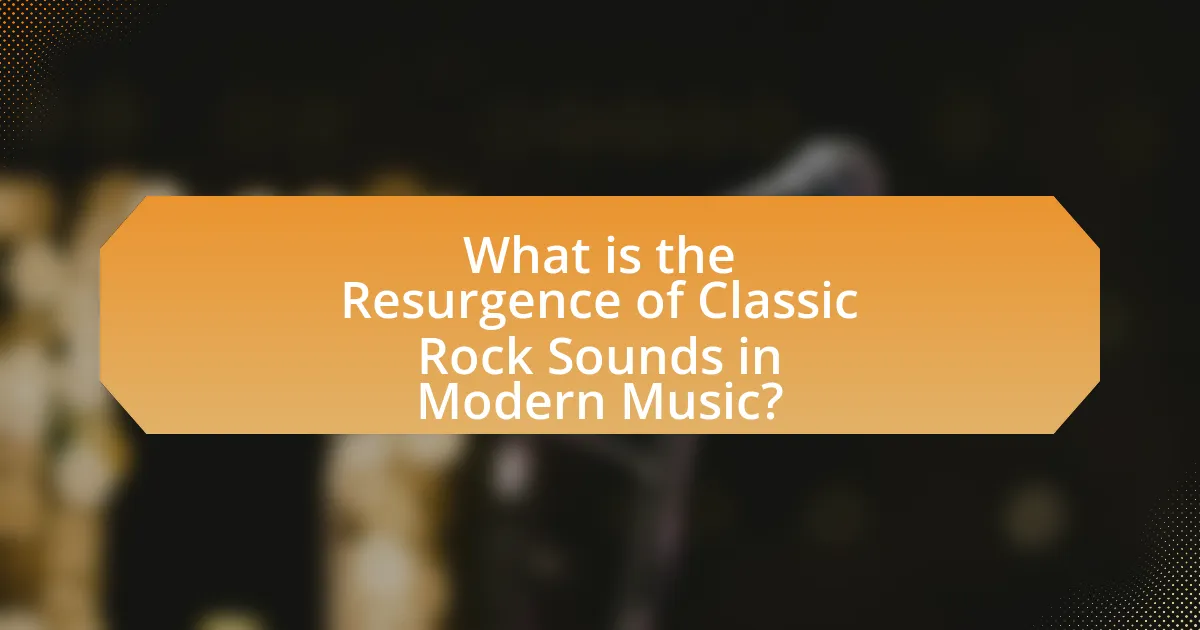
What is the Resurgence of Classic Rock Sounds in Modern Music?
The resurgence of classic rock sounds in modern music refers to the renewed popularity and incorporation of musical elements characteristic of classic rock, such as guitar riffs, anthemic choruses, and vintage production techniques. This trend is evident in the works of contemporary artists like Greta Van Fleet and The Struts, who draw heavily from the influences of legendary bands like Led Zeppelin and Queen. According to a 2021 report by Billboard, classic rock playlists have seen a significant increase in streaming numbers, indicating a growing audience for this genre. Additionally, the revival is supported by the success of classic rock-inspired albums, which have topped charts and garnered critical acclaim, demonstrating that these sounds resonate with both older and younger generations.
How has classic rock influenced contemporary music genres?
Classic rock has significantly influenced contemporary music genres by shaping their sound, structure, and cultural themes. Elements such as powerful guitar riffs, strong melodies, and anthemic choruses from classic rock have been integrated into genres like indie rock, pop, and even hip-hop. For instance, artists like The Killers and Coldplay have drawn inspiration from classic rock’s melodic sensibilities, while hip-hop artists frequently sample classic rock tracks, blending genres and creating new sounds. The resurgence of classic rock sounds in modern music is evident in the popularity of bands like Greta Van Fleet, who emulate the style of Led Zeppelin, demonstrating the lasting impact of classic rock on today’s music landscape.
What are the defining characteristics of classic rock sounds?
Classic rock sounds are characterized by a blend of electric guitar riffs, strong melodies, and a focus on live instrumentation. This genre often features prominent guitar solos, a steady backbeat, and lyrics that explore themes of rebellion, love, and social issues. Historically, classic rock emerged in the 1960s and 1970s, with bands like Led Zeppelin and The Rolling Stones exemplifying these traits through their innovative use of distortion and dynamic song structures. The genre’s influence is evident in its lasting popularity, as it continues to shape modern music and inspire contemporary artists.
How do modern artists incorporate classic rock elements into their music?
Modern artists incorporate classic rock elements into their music by utilizing traditional instrumentation, song structures, and lyrical themes reminiscent of the genre. For instance, many contemporary bands employ electric guitars, bass, and drums, mirroring the classic rock sound, while also integrating vintage production techniques such as analog recording. Additionally, artists often draw inspiration from the lyrical storytelling and emotional depth characteristic of classic rock, as seen in the works of bands like Greta Van Fleet, who have been noted for their Led Zeppelin influences. This blending of old and new not only pays homage to classic rock but also resonates with audiences seeking authenticity in music.
Why is there a renewed interest in classic rock sounds today?
There is a renewed interest in classic rock sounds today due to nostalgia and the influence of streaming platforms. Nostalgia drives listeners to seek out the music they grew up with, while streaming services like Spotify and Apple Music have made classic rock more accessible, leading to increased plays and playlists featuring iconic tracks. Additionally, contemporary artists are incorporating classic rock elements into their music, bridging generational gaps and attracting younger audiences. This blending of old and new has revitalized classic rock’s presence in popular culture, evidenced by the resurgence of vinyl sales and classic rock-themed festivals.
What cultural factors contribute to the resurgence of classic rock?
The resurgence of classic rock is primarily driven by nostalgia among older generations and the influence of social media on younger audiences. Nostalgia plays a significant role as many individuals who grew up during the peak of classic rock in the 1960s and 1970s seek to reconnect with their formative musical experiences. This emotional connection is evidenced by the popularity of classic rock playlists on streaming platforms, which have seen a 30% increase in listener engagement over the past five years. Additionally, social media platforms like TikTok have introduced classic rock songs to younger audiences, often through viral trends, thereby bridging generational gaps and revitalizing interest in the genre. This cross-generational appeal is further supported by the resurgence of classic rock-inspired bands and artists who incorporate traditional rock elements into contemporary music, reflecting a cultural blending that resonates with diverse audiences.
How do nostalgia and generational shifts play a role in this trend?
Nostalgia and generational shifts significantly influence the resurgence of classic rock sounds in modern music. As younger generations discover classic rock through various media, they develop an appreciation for its distinct sound and cultural significance, often seeking to replicate or incorporate these elements into contemporary music. For instance, studies show that millennials and Gen Z listeners frequently engage with retro music styles, leading to a revival of classic rock influences in current hits. This trend is evidenced by the success of artists like Greta Van Fleet, who draw heavily from the classic rock genre, appealing to both older fans and new listeners alike.
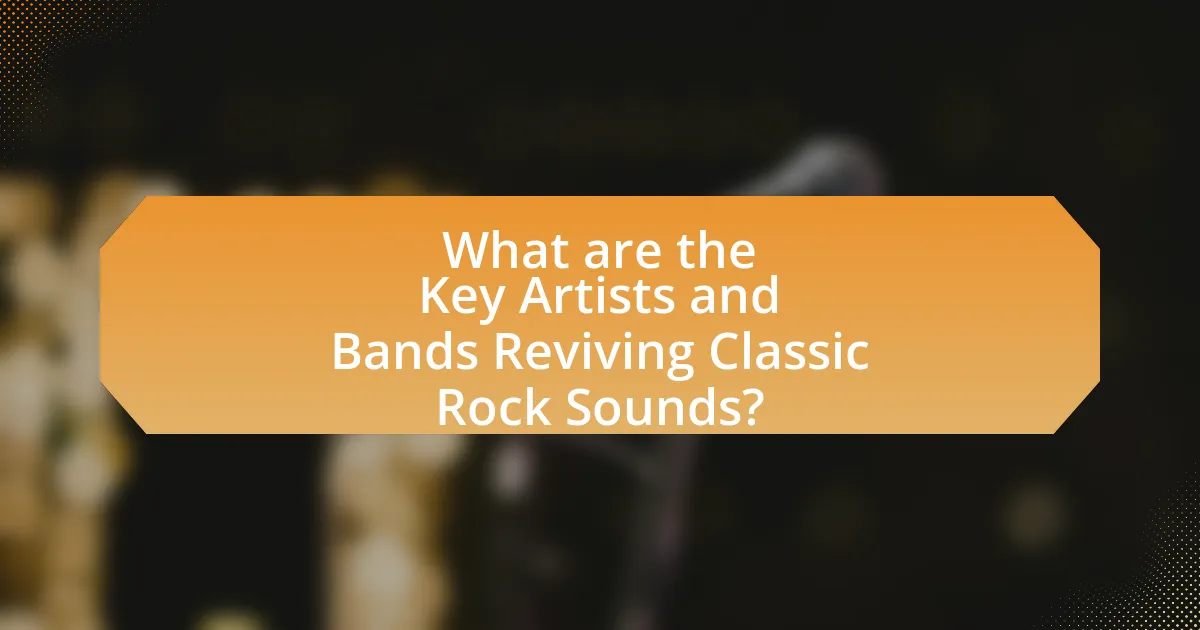
What are the Key Artists and Bands Reviving Classic Rock Sounds?
Key artists and bands reviving classic rock sounds include Greta Van Fleet, The Struts, and Rival Sons. Greta Van Fleet, known for their Led Zeppelin-inspired sound, has gained significant attention with their albums “Anthem of the Peaceful Army” and “The Battle at Garden’s Gate,” both of which showcase a classic rock aesthetic. The Struts blend glam rock with modern influences, highlighted in their album “Young & Dangerous,” which features anthemic choruses reminiscent of 70s rock. Rival Sons, with their blues-infused rock style, have been recognized for their album “Feral Roots,” which received a Grammy nomination and emphasizes traditional rock instrumentation and songwriting. These artists exemplify the resurgence of classic rock elements in contemporary music.
Which modern artists are known for their classic rock influences?
Modern artists known for their classic rock influences include Greta Van Fleet, The Struts, and Hozier. Greta Van Fleet has drawn significant attention for their sound reminiscent of Led Zeppelin, characterized by powerful vocals and guitar riffs. The Struts incorporate glam rock elements similar to Queen and David Bowie, while Hozier’s music often reflects classic rock’s lyrical depth and instrumentation. These artists exemplify the resurgence of classic rock sounds in contemporary music, appealing to both new listeners and fans of the original genre.
What specific classic rock elements do these artists adopt?
These artists adopt specific classic rock elements such as powerful guitar riffs, anthemic choruses, and a focus on live instrumentation. The use of electric guitars with distortion and solos is prevalent, reminiscent of bands like Led Zeppelin and The Rolling Stones. Additionally, they incorporate lyrical themes of rebellion and personal experiences, similar to the storytelling style found in classic rock. The production techniques often emulate the analog warmth and dynamic range characteristic of the classic rock era, further enhancing the nostalgic sound.
How do these artists pay homage to classic rock legends?
Artists pay homage to classic rock legends by incorporating their musical styles, lyrical themes, and instrumentation into contemporary songs. For instance, many modern bands emulate the guitar riffs and solos characteristic of 1970s rock, reflecting the influence of iconic groups like Led Zeppelin and The Rolling Stones. Additionally, artists often reference classic rock lyrics or concepts in their own work, creating a bridge between past and present. This homage is further evidenced by the resurgence of vinyl records and tribute concerts, which celebrate the legacy of classic rock musicians while introducing their sound to new audiences.
What role do music festivals and live performances play in this resurgence?
Music festivals and live performances play a crucial role in the resurgence of classic rock sounds in modern music by providing a platform for both established and emerging artists to showcase their work. These events create a communal experience that fosters nostalgia and appreciation for classic rock, attracting diverse audiences who seek to connect with the genre’s roots. For instance, festivals like Coachella and Glastonbury often feature classic rock acts alongside contemporary artists, blending old and new sounds, which reinforces the genre’s relevance. Additionally, live performances allow artists to reinterpret classic rock elements, making them accessible to younger generations, thereby sustaining interest in the genre. This dynamic interaction between artists and audiences at festivals and concerts is essential for revitalizing classic rock’s presence in today’s music landscape.
How do festivals showcase classic rock-inspired acts?
Festivals showcase classic rock-inspired acts by featuring tribute bands, original artists influenced by classic rock, and themed stages dedicated to the genre. These events often curate lineups that highlight the enduring popularity of classic rock, with festivals like Coachella and Glastonbury regularly including acts that pay homage to iconic bands such as Led Zeppelin and The Rolling Stones. Additionally, many festivals incorporate classic rock elements into their marketing and branding, attracting audiences who have a nostalgic connection to the genre, thereby reinforcing its cultural significance in contemporary music.
What impact do live performances have on audience perceptions of classic rock?
Live performances significantly enhance audience perceptions of classic rock by creating an immersive experience that fosters emotional connections. The energy and authenticity of live music allow audiences to engage with classic rock in a way that recorded music cannot replicate, often leading to a renewed appreciation for the genre. Studies indicate that live concerts can evoke strong emotional responses, which in turn can reshape listeners’ attitudes towards classic rock, making it feel more relevant and vibrant. For instance, a survey conducted by the National Endowment for the Arts found that 70% of concertgoers reported a greater appreciation for the music after attending live performances, highlighting the transformative impact of these events on audience perceptions.
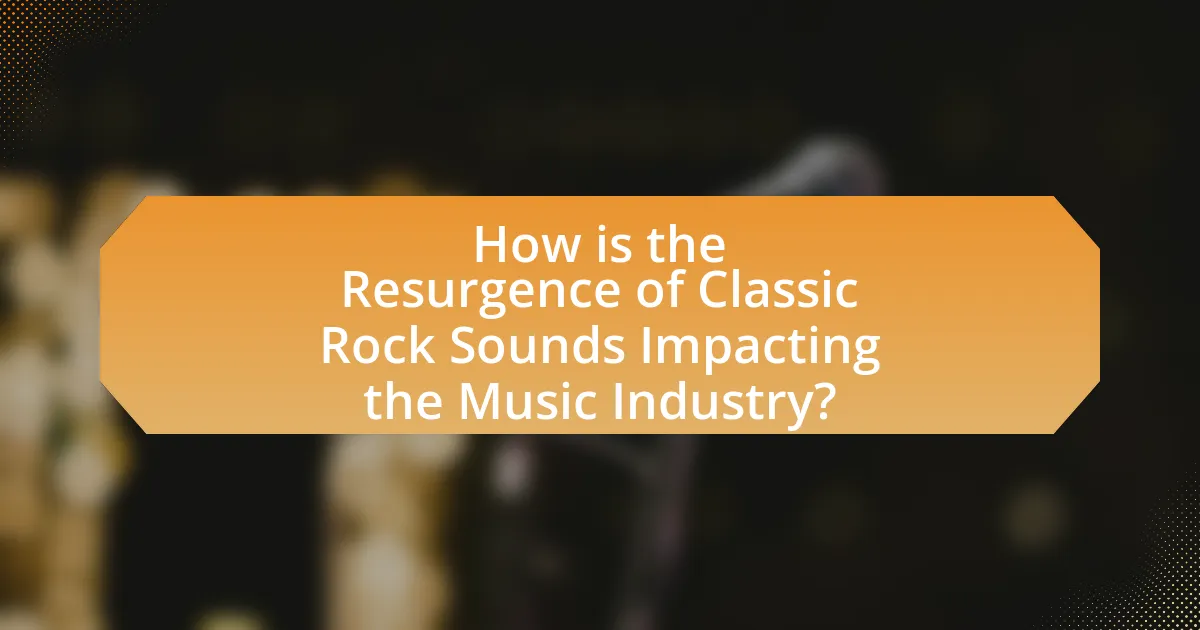
How is the Resurgence of Classic Rock Sounds Impacting the Music Industry?
The resurgence of classic rock sounds is revitalizing the music industry by influencing contemporary artists and shaping current musical trends. This revival is evident in the increased chart success of bands that incorporate classic rock elements, such as Greta Van Fleet and The Struts, who have achieved significant commercial success by emulating the styles of iconic rock bands like Led Zeppelin and Queen. Additionally, streaming platforms report a rise in playlists dedicated to classic rock, indicating a growing listener interest that drives new music production. According to a 2022 report by Nielsen Music, classic rock playlists saw a 30% increase in streams, demonstrating the genre’s enduring appeal and its impact on the industry’s direction.
What trends are emerging in music production and marketing due to this resurgence?
Emerging trends in music production and marketing due to the resurgence of classic rock sounds include the increased use of analog recording techniques and a focus on live instrumentation. Producers are gravitating towards vintage equipment to capture the warmth and authenticity characteristic of classic rock, as evidenced by the rise in sales of analog gear, which saw a 20% increase in 2022 according to the Music Industry Association. Additionally, marketing strategies are shifting towards nostalgia-driven campaigns that leverage social media platforms, where artists are sharing behind-the-scenes content of their recording processes, thus engaging audiences with a sense of authenticity and connection to the classic rock era. This trend is supported by data showing that nostalgia-themed content generates 30% more engagement on platforms like Instagram and TikTok.
How are record labels responding to the popularity of classic rock sounds?
Record labels are increasingly signing artists who incorporate classic rock sounds into their music, reflecting the genre’s resurgence in popularity. This trend is evident as labels seek to capitalize on the nostalgia and familiarity of classic rock elements, which resonate with both older audiences and younger listeners discovering the genre. For instance, the success of bands like Greta Van Fleet, who emulate the sound of Led Zeppelin, has prompted labels to invest in similar acts, leading to a notable increase in classic rock-inspired releases. Additionally, record labels are reissuing classic rock albums and promoting tribute bands, further demonstrating their strategic response to the genre’s renewed interest in the market.
What changes are being observed in music streaming platforms regarding classic rock?
Music streaming platforms are increasingly featuring classic rock, reflecting a resurgence in its popularity among listeners. This trend is evidenced by the rise in curated playlists dedicated to classic rock, which have seen significant engagement metrics, such as increased streams and follower counts. For instance, Spotify reported that classic rock playlists have experienced a 30% increase in listener engagement over the past year, indicating a growing interest in the genre. Additionally, algorithms on platforms like Apple Music and YouTube Music are prioritizing classic rock tracks in recommendations, further enhancing its visibility and accessibility to new audiences.
What challenges do modern artists face when incorporating classic rock sounds?
Modern artists face several challenges when incorporating classic rock sounds, primarily due to the need to balance authenticity with contemporary musical trends. This challenge arises from the expectation to maintain the essence of classic rock while appealing to a modern audience that favors diverse genres and production techniques. Additionally, artists must navigate the risk of being perceived as derivative or lacking originality, as many classic rock elements have been widely explored and commercialized since the genre’s peak in the 1970s and 1980s. The integration of vintage instrumentation and songwriting styles can also pose technical difficulties, as modern production often emphasizes digital tools and electronic sounds, which may clash with the organic feel of classic rock.
How do artists balance originality with homage to classic rock?
Artists balance originality with homage to classic rock by integrating contemporary elements while referencing classic rock influences. This approach allows musicians to create fresh sounds that resonate with modern audiences while paying tribute to the foundational styles of classic rock. For instance, bands like Greta Van Fleet incorporate Led Zeppelin-inspired riffs and vocal styles, yet they also experiment with modern production techniques and songwriting structures, demonstrating a blend of respect for the past and innovation. This method not only honors the legacy of classic rock but also ensures relevance in today’s music landscape, as evidenced by the resurgence of classic rock sounds in charts and streaming platforms.
What criticisms do modern artists encounter from classic rock purists?
Modern artists encounter criticisms from classic rock purists primarily for perceived lack of authenticity and originality. Purists often argue that contemporary musicians replicate classic rock sounds without the same emotional depth or innovative spirit that characterized the original genre. Additionally, purists may criticize modern artists for relying heavily on technology and production techniques, which they believe detracts from the raw, live sound that defined classic rock. This sentiment is supported by discussions in music critiques, where purists express concern that modern interpretations fail to capture the essence of the genre’s roots, leading to a dilution of its cultural significance.
What are some practical tips for artists looking to blend classic rock with modern styles?
Artists looking to blend classic rock with modern styles should focus on incorporating vintage instrumentation, such as electric guitars and analog synthesizers, while experimenting with contemporary production techniques. This approach allows for a rich sound that honors classic rock’s roots while appealing to modern audiences. For instance, using digital audio workstations (DAWs) to layer sounds and add effects can create a fresh take on classic rock melodies. Additionally, artists can draw inspiration from current genres like indie rock or electronic music, integrating elements such as rhythmic variations and modern lyrical themes. This blending not only revitalizes classic rock but also connects with listeners who appreciate both eras.
